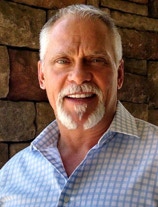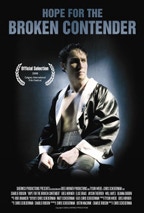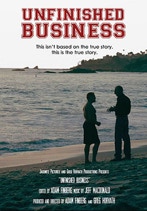Meet The Filmmakers
Greg Horvath, Producer
Greg resides in Los Angeles, CA and is a nationally respected motivational speaker, author and producer.
The Business of Recovery is the third feature film Greg has produced. Unfinished Business was considered for a Canadian Gemini Award, and Hope for the Broken Contender won the American Express People’s Choice award at the Calgary International Film Festival. He views the world through the lens that anyone can build a life they are proud to lead.
Greg is very passionate about The Business of Recovery, a story he felt compelled to tell.


View UNFINISHED BUSINESS, Greg's incredible story of living his dream to play college football at age 38!

View Greg's best selling book
DIARY OF A SOBER COMPANION

Adam Finberg, Director
Adam is a Los Angeles based filmmaker. He is a graduate of Northwestern University and the American Film Institute’s Directing program. His award-winning directing work spans a wide spectrum of media from national TV commercials to groundbreaking music videos, films and documentaries, including the revealing After Katrina: Rebuilding St. Bernard Parish that chronicled the post-hurricane life in a small community. He has also been a lead editor on unscripted hit television shows for a variety of networks including Discovery, WETV, Lifetime, MSNBC, History, TruTV, Oxygen, ABC, CMT, Showtime, VH1 and MTV.
Adam originally met Greg Horvath in 2005 and directed a documentary about his inspirational story of recovery and self-improvement. Greg had been sober since 1990,
and had decided in 1999, at age 38, to pursue his lifelong dream of going to college and playing football. He has told his story many times at motivational talks and working with other addicts.
In 2011, after Greg had spent several years working in the treatment world, he approached Adam about directing The Business of Recovery. He had seen firsthand the enormous amounts of money exchanged for services that were not delivering as promised, and he felt very strongly that the system needed to change.
As a filmmaker, Adam was intrigued by the challenge of exploring a complex problem that, starting out, he knew little about. He approached the film’s premise with open eyes, and what he discovered astounded him. Adam quickly learned that so many families had hidden stories to tell about a family member with an addiction problem, looking for a solution. When Greg and Adam started researching the numbers of deaths involving substance abuse and compared it to the size of the industry, they saw that more and more money was being spent on addiction every year, with no abatement in the human cost. Adam’s hope is that the film will lead to better oversight of an industry that makes wild claims, and spark a deeper mental health discussion about the realities of how to help those who are struggling with addiction and their families.
Production Notes
Greg worked for over a decade in the addiction treatment industry. In that time he observed the same suspect treatment practices over and over again with everything from kickbacks and referral fees to antiquated treatment administered by untrained staff.
He watched as hundreds of people were caught in the myth of recovery. It became a self-serving cycle—spend big money on treatment, get out and relapse, spend big money on treatment, get out and relapse. With few exceptions, the recovery process never ended and individuals were caught in a cycle of continued treatment attempts. Greg began wondering if there was a better way. He would ask the treatment providers why they didn’t change how to treat addiction given the high rate of failure, but his questions were always quickly dismissed.
After a number of years of witnessing this horrific cycle of failure, Greg had enough. He could no longer stand idly by and not take action. He decided the only way to make the behemoth addiction treatment industry change would be by exposing its shortcomings.
In 2010, Greg started researching all aspects of the addiction treatment industry in the United States. Even after many years of observing sub-par services, the results shocked him.
His next step was to find a director that would be able to tell this incredible story—Greg found Adam Finberg.
They traveled all over the United States to talk to people from all aspects of the addiction treatment industry; scientists, medical doctors, psychologists, and some of the most recognizable treatment providers in the country if not the world.
The film highlights many experts in the field of recovery, including:
Ruben Baler a Health Scientist from NIDA (The National Institute Drug Abuse) in Bethesda, MD;
Dr. William R. Miller from the University of New Mexico, who has participated in dozens of clinical trials, written 40 books and has over 400 professional publications to his name;
Dr. Lance Dodes, an author, addiction expert and a graduate of Harvard medical school, and
Stuart Finkelstein M.D., an addictionologist, who’s treated thousands of addiction patients spanning his 30 year career.
Early on, Greg and Adam knew it was important for the treatment centers to be a part of the film. We were allowed access to a number of treatment centers including The Betty Ford Center in Rancho Mirage, CA, Hazelden in Center City, MN, High Watch Recovery
(co-founded by Bill Wilson, the founder of Alcoholics Anonymous) in Somers, CT and Seasons Recovery in Malibu, CA. They also spoke with the president of the National Association of Addiction Treatment Providers.
While there was unfortunately no shortage of families with horror stories about treatment, getting them to speak about it publicly on camera was not an easy task. Eventually Greg and Adam found courageous families who were currently dealing with the devastating effects of an addicted loved one for whom the addiction treatment process had failed. They wanted to help prevent others from going through the same experience. Their heart wrenching and emotional stories unfold in real time throughout the film.
The goal of this film is to bring is to awareness to the gross deficiencies of how the industry approaches the treatment of addiction. The overwhelming number people that die each year in the US from addiction is proof that the industry fails miserably at treating addiction, but it has not changed; it has only grown. Unfortunately for the families interviewed, and other families with similar stories across the U.S., the treatment industry is hugely profitable, bringing in billions for business - while deaths pile up.
Adam and Greg are calling for a change within the industry and believe that the public will demand action after watching the documentary. The industry must change. There must be oversight and regulations in place that protect the public and the families who are entrusting these centers with their loved ones. Treatment needs to be more scientific and empirically validated. The educational requirements for people treating addiction must be higher. Together, we can substantially improve the way we treat addiction.
Other films by Greg Horvath

